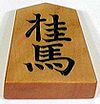 Shogi
Shogi  Movement and capture 2
Movement and capture 2
Movement and capture 2
King
A King can move one square in any direction, orthogonal or diagonal.
| ??? | ??? |
|
Rook
A rook can move any number of free squares along any one of the four orthogonal directions.
| ??? | ??? |
|
Bishop
A bishop can move any number of free squares along any one of the four diagonal directions.
| ??? | ??? |
|
Because they cannot move orthogonally, the opposing unpromoted bishops can only reach half the squares of the board, unless they are captured and then dropped by the opposing player.
Gold general
A gold general can move one square orthogonally, or one square diagonally forward, giving it six possible destinations. It cannot move diagonally backward.
| ??? | ??? |
|
Silver general
A silver general can move one square diagonally or one square directly forward, giving it five possibilities.
| ??? | ??? |
|
Because an unpromoted silver can retreat more easily than a promoted one (see below), it is very common to leave a silver unpromoted at the far side of the board.
Knight
A knight jumps at an angle intermediate between orthogonal and diagonal, amounting to one square forward plus one square diagonally forward, in a single motion. That is, it has a choice of two forward destinations. It cannot move to the sides or backwards.
| ??? | ??? |
|
The knight is the only piece that ignores intervening pieces on the way to its destination. It is not blocked from moving if the square in front of it is occupied, but neither can it capture a piece on that square.
It is often useful to leave a knight unpromoted (see below) at the far side of the board. However, since a knight cannot move backward or to the sides, it must promote when it lands on one of the two far ranks and would otherwise be unable to move further.
Lance
A lance can move any number of free squares directly forward. It cannot move backward or to the sides.
| ??? | ??? |
|
It is often useful to leave a lance unpromoted (see below) at the far side of the board. However, since a lance cannot move backward or to the sides, it must promote if it arrives at the far rank.
Pawn
A pawn can move one square directly forward. It cannot retreat.
| ??? | ??? |
|
Since a pawn cannot move backward or to the sides, it must promote (see below) if it arrives at the far rank. However, in practice, a pawn is promoted whenever possible.
Unlike the pawns of international chess, shogi pawns capture the same way they otherwise move, directly forward.
There are two restrictive rules for where a pawn may be dropped. (See below.)








